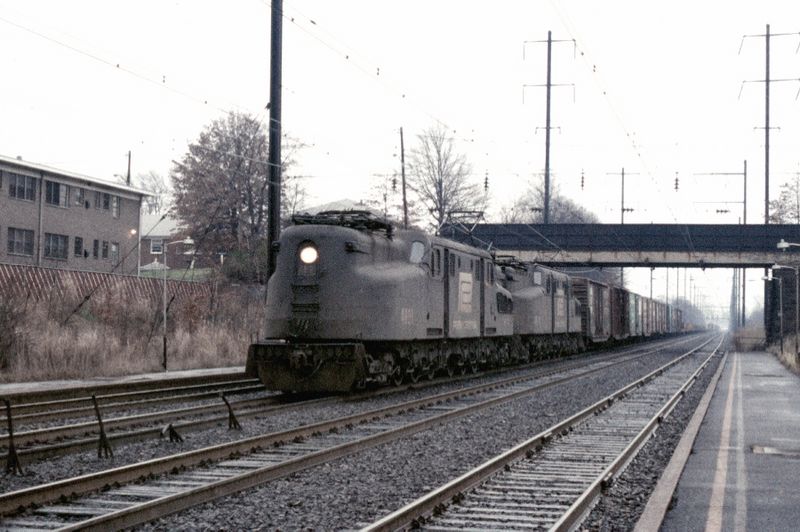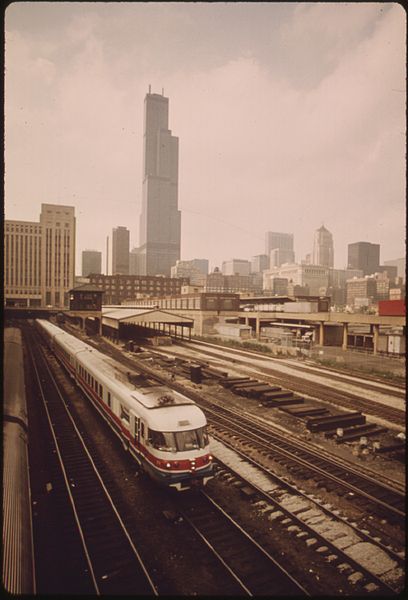1973-1975
A Penn Central train in 1975, a remnant of what had caused the railroad industry to be turned upside down in the US
The slow rot of the freight railroads of the United States continued, despite being relieved of their passenger operations. In most areas of the north east of the US, there were just too many railroads to maintain, and too many small railroads for the system to be efficient, for the companies to be profitable. The bankruptcy of Penn Central in 1971 started things; many smaller railroads were toppled in a domino effect, a large factor being Penn Central's inability to pay the smaller railroads the trackage fees due. The mess of Pen Central, and the inability of the US economy to let rail operations simply halt, led to the US Congress to oversee the creation of the "US Railroad Administration". The USRA was, in effect, a government owned corporation whose task would be to create a new freight network by picking routes out of the bankrupt railroads to maintain. The rest would be disbanded, or handed over to Amtrak.
Big changes were also due in the Mid-West in 1973 - Turboliner trains came into service, serving on the Chicago to Minneapolis route through Milwaukee, as well as Chicago - Detroit / Cleveland through Fort Wayne. All the routes would have several departures per day, reflecting Amtrak's belief that these routes could generate far more patronage and thus revenue. Coupled with good deals on both day and weekend trips, people started to flock to the services, attracted by the city-centre locations and more modern trains. A knock-on effect, to try to make the routes more efficient, was the renovation of Chicago Union station. By design, the station was a terminus for services in both direction, with little opportunity for through running. Amtrak's plan would change all that. Most of the shops and services sat between the tracks would move into the Great Hall, with the eastern 8 pairs of tracks being connected through the station to make 8 "through" tracks complete with platforms. This will enable Minneapolis - Chicago services to run straight on to Detroit / Cleveland. While there is likely to be little demand for Minneapolis - Detroit services, it means that time spent sitting at Chicago being turned around can be avoided, and commuter services can be run across Chicago as well.
The role of the 1970s oil crisis should not be overlooked either; people low on fuel turned to Amtrak in great numbers during the crisis, and the overall rising (and unpredictable) cost of fuel had a great - and long lasting - impact on Amtrak. It would spur Amtrak's desire to properly electrify the whole of the North East Corridor (ideally with one system to reduce operation complexity) to avoid having to buy fuel for services on this route, which could also have knock on benefits for commuter rail operations based off the NEC.
By 1975, the USRA was getting a better idea of what routes it wanted to maintain within a Consolidated Railway Corporation. Amtrak was also rapidly coming up with a map of routes it wanted to take over for it's commuter operations, in areas all around the main cities. Where it could afford to, it wanted to own the lines. Where such transfers would be impossible, due to heavy freight traffic or likely insufficient demand, Amtrak would seek to partner with Conrail (or other freight railroads) and pay to run it's trains over the freight lines.
Amtrak's long distance routes were suffering from problems, primarily from equipment failures. In part this was down to the old-age of much of the rolling stock, and coupled with little investment occurring on the lines by Amtrak, this was driving passengers away. Even on the North East Corridor, the Budd Metroliners were becoming unreliable. This would need changing, or Amtrak could lose it's biggest potential for revenue. New passenger coaches, to replace the old and unreliable coaches inherited from it's predecessor railroads were required, and orders were placed in 1973 for a fleet of
Amfleet passenger coaches. From 1975 onwards, deliveries commenced, giving Amtrak a high quality passenger coach to accommodate it's travellers. These would be the first in long line of Amtrak rolling stock, and did wonders in overhauling perceptions of Amtrak. No more was Amtrak solely a relic of the past, using old coaches and sitting in old and dusty seats. Now, from the passenger eye, Amtrak was the train of comfort. A related order was the large order for dual level
Superliner passenger coaches, mainly intended for Amtrak's long-distance routes where Amtrak wanted to run as few trains as possible while gaining the maximum revenue. However, those trains also needed to move at speed in order to really compete and provide an attractive service, and so Amtrak started hunting for a new locomotive, fully owned (rather then leased) by them and designed for passenger operation with higher top speed and faster acceleration.
All in all, this period of Amtrak's history was mostly defined by trying to keep trains running and in service, earning revenue. Most programmes that Amtrak had commenced would not come to fruit for a few more years. Passenger levels were rising on the corridors that Amtrak had invested in (primarily Chicago to Minneapolis and Washington to New York), but the weight of running a nationwide intercity service weighed heavily on Amtrak's financial accounts. It was clear that significant investment would be required in order to offset years of deferred maintenance on it's routes, and give Amtrak a fighting chance of survival. This was something that Amtrak heavily lobbied for, and big changes to the railroad scene would commence in 1976.
A Turboliner train departing from Chicago
-------------------------------
Notes: Not much has changed here yet...it's still a little early for butterflies to take large effect. Amfleet coaches are on the way in, replacing old stock, as these are the real purveyors of the "experience" of train travel for passengers...and are somewhat future proof being capable of up to 125mph. A better rail service (I'd speculate at maybe 3 departures per day) will start to entice some passengers to travel by train down to Chicago.
The biggest change here so far is the attempted conversion of Chicago Union into a through station. This is absolutely critical to an efficient network, allowing routes to be merged together, which saves on rolling stock requirements. Terminus stations mean that firstly passengers have to change trains to cross Chicago, and also means wasted time while the train is sat in the terminus platforms being turned around - which again is lost revenue when a train is sat still. Expect to see both express and commuter rail lines joined together.
The Turboliners, in OTL, did serve in the Mid-West but on the Chicago - St Louis route - which isn't an Amtrak owned route.
Yet!
Much bigger changes to come in the next segment 1976-1978


